
Teaching students how to retell a story to their peers or teachers.
- Subject:
- Reading Foundation Skills
- Material Type:
- Lecture Notes
- Author:
- Kelsey Blue
- Date Added:
- 10/27/2021

Teaching students how to retell a story to their peers or teachers.

Contains tool overview and student examples

This packet assists parents and teachers transition to distance learning.


This packet assists parents and teachers transition to distance learning.
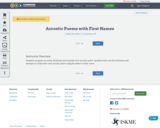
Students are given an online dictionary and exampe of an acrostic poem. Students then use the dictionary and example to create thier own acrostic poem using the letters in their name.
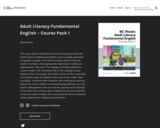
Short Description:
This course pack is designed to meet the learning outcomes for Adult Literacy Fundamental English Level 1 (roughly equivalent to beginner to grade 1.5 in the K-12 system). Every of the nine chapters includes a level-appropriate, high-interest reading of approximately 100 words. The readings are freely available in a separate reader with convenient links to the readings in each chapter of this course pack. The online version of this course pack also contains audio recordings of each story in the reader. These recordings, combined with vocabulary and word pattern exercises, prepare the Level 1 student to read each paragraph-long text with greater independence. Font size and line spacing can be adjusted in the online view, and have been enhanced for the print and PDF versions for easier reading. This course pack has been reviewed by subject experts from colleges and universities.
Long Description:
This course pack is designed to meet the learning outcomes for Adult Literacy Fundamental English Level 1 (roughly equivalent to beginner to grade 1.5 in the K-12 system). Every one of the nine chapters includes a level-appropriate, high-interest reading of approximately 100 words.
The readings are freely available in a separate reader with convenient links to the readings in each chapter of this course pack. The online version of this course pack also contains audio recordings of each story in the reader. These recordings, combined with vocabulary and word pattern exercises, prepare the Level 1 student to read each paragraph-long text with greater independence. Depending on a learner’s readiness, you may wish to use the sentences in the Word Pattern sections as dictation. Exercises on the connections between consonant sounds and letters are beyond the scope of these books. I recommend using these books alongside a structured phonics program, such as the Wilson Reading System.
Each course pack chapter includes pre-reading questions that can be used for individual reflection or class discussion, vocabulary-building and word pattern exercises, comprehension questions, grammar lessons and practice exercises, and a writing task. Font size and line spacing can be adjusted in the online view, and have been enhanced for the print and PDF versions for easier reading. This course pack has been reviewed by subject experts from colleges and universities.
Word Count: 9630
(Note: This resource's metadata has been created automatically by reformatting and/or combining the information that the author initially provided as part of a bulk import process.)
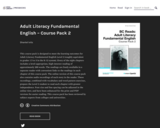
Short Description:
This course pack is designed to meet the learning outcomes for Adult Literacy Fundamental English Level 2 (roughly equivalent to grades 1.5 to 3 in the K-12 system). Every of the eight chapters includes a level-appropriate, high-interest reading of approximately 200 words. The readings are freely available in a separate reader with convenient links to the readings in each chapter of this course pack. The online version of this course pack also contains audio recordings of each story in the reader. These recordings, combined with vocabulary and word pattern exercises, prepare the Level 2 student to read each chapter with greater independence. Font size and line spacing can be adjusted in the online view, and have been enhanced for the print and PDF versions for easier reading. This course pack has been reviewed by subject experts from colleges and universities.
Long Description:
This course pack is designed to meet the learning outcomes for Adult Literacy Fundamental English Level 2 (roughly equivalent to grades 1.5 to 3 in the K-12 system). Every of the eight chapters includes a level-appropriate, high-interest reading of approximately 200 words.
The readings are freely available in a separate reader with convenient links to the readings in each chapter of this course pack. The online version of this course pack also contains audio recordings of each story in the reader. These recordings, combined with vocabulary and word pattern exercises, prepare the Level 2 student to read each chapter with greater independence. Depending on a learner’s readiness, you may wish to use the sentences in the Word Pattern sections as dictation. It is recommended that these books are used alongside a structured phonics program, such as the Wilson Reading System.
Each course pack chapter includes pre-reading questions that can be used for individual reflection or class discussion, vocabulary-building and word pattern exercises, comprehension questions, grammar lessons and practice exercises, and a writing task. Font size and line spacing can be adjusted in the online view, and have been enhanced for the print and PDF versions for easier reading. This course pack has been reviewed by subject experts from colleges and universities.
Word Count: 10548
(Note: This resource's metadata has been created automatically by reformatting and/or combining the information that the author initially provided as part of a bulk import process.)
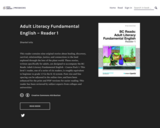
Short Description:
This reader contains nine original stories about healing, discovery, survival, relationships, justice, and connections to the land explored through the lens of the plant world. These stories, written specifically for adults, are designed to accompany the BC Reads: Adult Literacy Fundamental English - Course Pack 1. This level 1 reader, one of a series of six readers, is roughly equivalent to beginner to grade 1.5 in the K-12 system. Font size and line spacing can be adjusted in the online view, and have been enhanced for the print and PDF versions for easier reading. This reader has been reviewed by subject experts from colleges and universities.
Long Description:
This reader contains nine original stories about healing, discovery, survival, relationships, justice, and connections to the land explored through the lens of the plant world. These stories, written specifically for adults, are designed to accompany the BC Reads: Adult Literacy Fundamental English – Course Pack 1. This level 1 reader, one of a series of six readers, is roughly equivalent to beginner to grade 1.5 in the K-12 system. Font size and line spacing can be adjusted in the online view, and have been enhanced for the print and PDF versions for easier reading. This reader has been reviewed by subject experts from colleges and universities.
Word Count: 3018
(Note: This resource's metadata has been created automatically as part of a bulk import process by reformatting and/or combining the information that the author initially provided. As a result, there may be errors in formatting.)
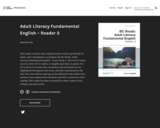
This reader contains nine original stories written specifically for adults, and is designed to accompany the BC Reads: Adult Literacy Fundamental English – Course Pack 3. This level 3 reader, one of a series of six readers, is roughly equivalent to grades 3 to 4.5 in the K-12 system.The units in this reader mirror those in the course pack.

Word Count: 100647
(Note: This resource's metadata has been created automatically by reformatting and/or combining the information that the author initially provided as part of a bulk import process.)
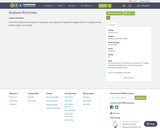
Preschool storytime featuring books, fingerplays, and songs about flying which engage children in playing, writing, talking, singing, and reading.
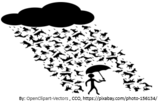
This seminar will introduce three of eight types of figurative language (alliteration, onomatopoeia, and idiom). Through mainly fictional texts( tongue twisters, comics, songs, etc.), you will identify these types of figurative language, determine their meanings, and formulate project-based activities to prove your understanding of these common figurative language types.StandardsCC.1.2.5.F Determine the meaning of words and phrase as they are used in grade-level text, including interpretation of figurative language.

Cover Sheet
Teacher Examples
Template


In this seminar you will be engaged by video, text, and activities that will help you identify and explain the “Author’s Purpose” of printed material. You will be using habits of mind which focus on clarity in communication, as well as accessing prior knowledge to make new decisions regarding the purpose of text. Realize that authors of any printed material have a reason for writing. Understanding this purpose will help you develop your own comprehension and writing skills.StandardsCC.1.2.6.D - Determine an author’s point of view or purpose in a text and explain how it is conveyed in the text.
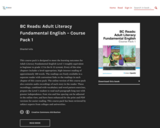
Short Description:
This course pack is designed to meet the learning outcomes for Adult Literacy Fundamental English Level 1 (roughly equivalent to beginner to grade 1.5 in the K-12 system). Every of the nine chapters includes a level-appropriate, high-interest reading of approximately 100 words. The readings are freely available in a separate reader with convenient links to the readings in each chapter of this course pack. The online version of this course pack also contains audio recordings of each story in the reader. These recordings, combined with vocabulary and word pattern exercises, prepare the Level 1 student to read each paragraph-long text with greater independence. Font size and line spacing can be adjusted in the online view, and have been enhanced for the print and PDF versions for easier reading. This course pack has been reviewed by subject experts from colleges and universities.
Long Description:
This course pack is designed to meet the learning outcomes for Adult Literacy Fundamental English Level 1 (roughly equivalent to beginner to grade 1.5 in the K-12 system). Every one of the nine chapters includes a level-appropriate, high-interest reading of approximately 100 words.
The readings are freely available in a separate reader with convenient links to the readings in each chapter of this course pack. The online version of this course pack also contains audio recordings of each story in the reader. These recordings, combined with vocabulary and word pattern exercises, prepare the Level 1 student to read each paragraph-long text with greater independence. Depending on a learner’s readiness, you may wish to use the sentences in the Word Pattern sections as dictation. Exercises on the connections between consonant sounds and letters are beyond the scope of these books. I recommend using these books alongside a structured phonics program, such as the Wilson Reading System.
Each course pack chapter includes pre-reading questions that can be used for individual reflection or class discussion, vocabulary-building and word pattern exercises, comprehension questions, grammar lessons and practice exercises, and a writing task. Font size and line spacing can be adjusted in the online view, and have been enhanced for the print and PDF versions for easier reading. This course pack has been reviewed by subject experts from colleges and universities.
Word Count: 9531
ISBN: 978-1-989623-75-6
(Note: This resource's metadata has been created automatically by reformatting and/or combining the information that the author initially provided as part of a bulk import process.)
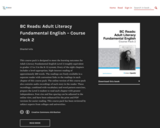
Short Description:
This course pack is designed to meet the learning outcomes for Adult Literacy Fundamental English Level 2 (roughly equivalent to grades 1.5 to 3 in the K-12 system). Every of the eight chapters includes a level-appropriate, high-interest reading of approximately 200 words. The readings are freely available in a separate reader with convenient links to the readings in each chapter of this course pack. The online version of this course pack also contains audio recordings of each story in the reader. These recordings, combined with vocabulary and word pattern exercises, prepare the Level 2 student to read each chapter with greater independence. Font size and line spacing can be adjusted in the online view, and have been enhanced for the print and PDF versions for easier reading. This course pack has been reviewed by subject experts from colleges and universities.
Long Description:
This course pack is designed to meet the learning outcomes for Adult Literacy Fundamental English Level 2 (roughly equivalent to grades 1.5 to 3 in the K-12 system). Every of the eight chapters includes a level-appropriate, high-interest reading of approximately 200 words.
The readings are freely available in a separate reader with convenient links to the readings in each chapter of this course pack. The online version of this course pack also contains audio recordings of each story in the reader. These recordings, combined with vocabulary and word pattern exercises, prepare the Level 2 student to read each chapter with greater independence. Depending on a learner’s readiness, you may wish to use the sentences in the Word Pattern sections as dictation. It is recommended that these books are used alongside a structured phonics program, such as the Wilson Reading System.
Each course pack chapter includes pre-reading questions that can be used for individual reflection or class discussion, vocabulary-building and word pattern exercises, comprehension questions, grammar lessons and practice exercises, and a writing task. Font size and line spacing can be adjusted in the online view, and have been enhanced for the print and PDF versions for easier reading. This course pack has been reviewed by subject experts from colleges and universities.
Word Count: 10538
(Note: This resource's metadata has been created automatically by reformatting and/or combining the information that the author initially provided as part of a bulk import process.)
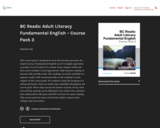
Short Description:
This course pack is designed to meet the learning outcomes for Adult Literacy Fundamental English Level 3 (roughly equivalent to grades 3 to 4.5 in the K-12 system). Every chapter within the three units includes a level-appropriate, high-interest reading of between 350 and 500 words. The readings are freely available in a separate reader with convenient links to the readings in each chapter of this course pack. For students using this program in a self-paced format, there are audio clips embedded throughout the course pack. These clips narrate the denser sections of text. Font size and line spacing can be adjusted in the online view, and have been enhanced for the print and PDF versions for easier reading. This course pack has been reviewed by subject experts from colleges and universities.
Long Description:
This course pack is designed to meet the learning outcomes for Adult Literacy Fundamental English Level 3 (roughly equivalent to grades 3 to 4.5 in the K-12 system). Every chapter within the three units includes a level-appropriate, high-interest reading of between 350 and 500 words. The readings are freely available in a separate reader with convenient links to the readings in each chapter of this course pack.
Each unit begins with a lesson related to Skills and Strategies for Learning”, and continues with a reading strategy; a word attack strategy; exercises for identifying subject, main idea, details, and sequence; a grammar rule; and finally, writing conventions. This course pack makes use of a number of graphic organizers to help students order their thoughts in a visual way. For students using this program in a self-paced format, there are audio clips embedded throughout the course pack. These clips narrate the denser sections of text.In the appendix, there are rubrics tailored to score each of the writing tasks assigned at the end of each chapter. Font size and line spacing can be adjusted in the online view, and have been enhanced for the print and PDF versions for easier reading. This course pack has been reviewed by subject experts from colleges and universities.
Word Count: 14485
(Note: This resource's metadata has been created automatically by reformatting and/or combining the information that the author initially provided as part of a bulk import process.)
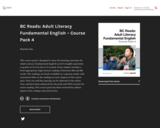
Short Description:
This course pack is designed to meet the learning outcomes for Adult Literacy Fundamental English Level 4 (roughly equivalent to grades 4.5 to 6 in the K-12 system). Every chapter includes a level-appropriate, high-interest reading of between 400 and 500 words. The readings are freely available in a separate reader with convenient links to the readings in each chapter of this course pack. Font size and line spacing can be adjusted in the online view, and have been enhanced for the print and PDF versions for easier reading. This course pack has been reviewed by subject experts from colleges and universities.
Long Description:
This course pack is designed to meet the learning outcomes for Adult Literacy Fundamental English Level 4 (roughly equivalent to grades 4.5 to 6 in the K-12 system). Every chapter includes a level-appropriate, high-interest reading of between 400 and 500 words. The readings are freely available in a separate reader with convenient links to the readings in each chapter of this course pack. Each chapter includes pre-reading questions that can be used for individual reflection, journalling or class discussion, vocabulary-building exercises, a word attack strategy, comprehension questions, grammar lessons and practice exercises, and a writing task.
This course pack makes use of a number of graphic organizers to help students order their thoughts in a visual way. In the appendix, there are: a list of all graphic organizers and forms used in the course pack, writing assessment checklists, and recommended films about the people discussed in the course pack and reader. Font size and line spacing can be adjusted in the online view, and have been enhanced for the print and PDF versions for easier reading. This course pack has been reviewed by subject experts from colleges and universities.
Word Count: 18853
(Note: This resource's metadata has been created automatically by reformatting and/or combining the information that the author initially provided as part of a bulk import process.)